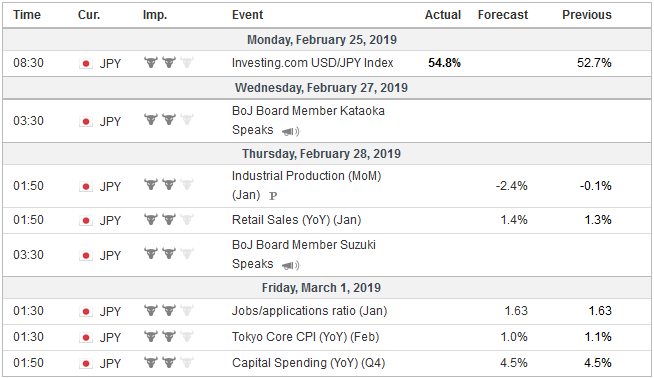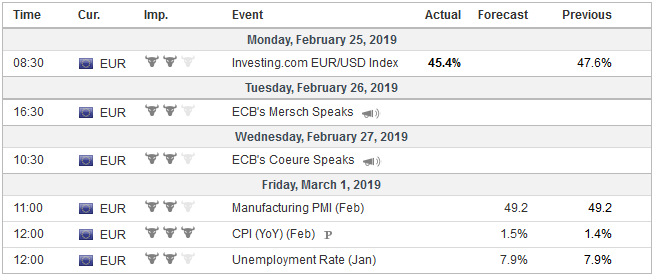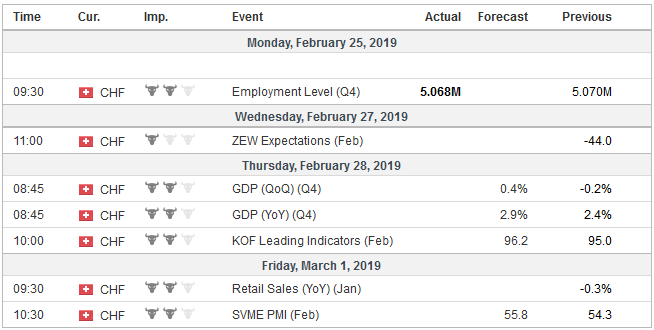After a dismal end of 2018, investors are faring better through the first two- thirds of the Q1 19. Equity markets have recouped a good part of the late-2018 decline. Bond yields, however, have not returned to where they previously were. The tightening of financial conditions, which was both cause and effect of heightened anxiety among investors, and spooked some central bank have eased considerably. The volatility of stocks, bonds, and the dollar-yen and the euro-dollar exchange rates have fallen.
While the capital markets are calmer, the underlying uncertainties remain as stark as they were in December. The US and China are engaged in trade talks, and while some agreement is widely expected, the strategic competition between the two remains fierce. The Irish border remains the same vexing issue for Brexit, and after 18 months of negotiating, the risks of a no-deal exit remains palpable. Dutch negotiators have reportedly put the odds at 60%.
What Brexit and the US-China trade talks have in common is that the self-imposed deadlines are likely to be extended. Before the weekend, Treasury Secretary Mnuchin was quoted on the news wires indicating that an agreement on the yuan had been reached. There were no details and investors did not seem to react much, but whatever the substantive details are, the agreement offers a prima facia case of extending the tariff freeze.
The length of the extension is a practical issue. When can the two presidents meet? Reports suggest that a meeting could be held at one of Trump’s properties at the end of next month. Investors should not be mistaken. A trade agreement, at best, sets some parameters around the strategic competition. Consider that around the same time that Munchin was announcing the currency agreement, Defense Secretary Pompeo was declaring that the US would not share information with countries that using Huawei systems.
US equities closed on their highs before the weekend, and many attributed it to the optimism on trade. The S&P 500 and NASDAQ closed at their best levels since early November ostensibly on this anticipation. In fairness, both benchmarks have advanced in eight of the past nine weeks and are up 11.4% and 13.4% respectively. Investors have been confident that a deal would be struck and other factors are helping the stock market recover from the sell-off from the record highs made in last Q3 18.
Again, regardless of the substance, or indeed lack thereof, in the currency agreement, signifies that the peak in US-Chinese trade tensions, in this cycle, are past. The focus will shift toward Europe and Japan. The Trump Administration places emphasis on economic rivalry, and from that perspective, Europe and Japan challenge US national interest as much as China.
Indeed, the Trump Administration arguably represents a vigorous pursuit of US national interest, and although some had complained about the of US leadership, many seem to be chafing under its new expression. The US is demanding others follow it in three issues in relatively quick succession without apparently offering inducements of any kind. The US unilaterally withdrew from the Iran treaty and has threatened to punish those who violate the embargo. We noted that the US insistence that allies ban Huawei systems. The US also wants others to recognize Guaido as leader of Venezuela, though some allies, including Mexico, is reluctant, perhaps for historical reasons, to avoid getting involved in other countries’ domestic politics.
The game of brinkmanship requires a willingness to go to the brink. Prime Minister May wants to the bill that her government negotiated with the EU to be approved by the House of Commons. They rejected it in historic fashion. As the risk of leaving at the end of next month without an agreement rises, May’s negotiated deal, perhaps wrapped in some legal-ease that states intention to resolve the issue with all due deliberate effort and in a timely fashion, will look like the better alternative.
Like the US-China trade talks, the market has long anticipated that the UK would not leave the EU at the end of March. This has arguably been an important factor helping lift sterling this year. It is the second strongest of the major currencies, behind the Canadian dollar. It’s 2.3% gain this year this year, offsets in full its Q4 18 loss.
Two questions immediately follow. How long of a delay and what is its purpose? The EU Parliament election is at the end of May. Ideally, the delay would not be beyond the elections, or if absolutely necessary, for only the shortest of time. Reports suggested that EC officials were anticipating a request for a 60-day extension.
The purpose is a bit trickier. What would change? The EC’s position most likely would not. It cannot accept a sunset clause to the backstop. It defeats the purpose. It will not re-open the Withdrawal Bill. It was negotiated for 18 months. It is content with it.
Given the potentially disastrous consequences of a no-deal exit, a short sacrifice to the Fortuna that common sense and reason can prevail if given a bit more time may be an adequate reason for some. For the realists, a 60-day extension only makes sense, it would seem, if there was a reasonable chance that the UK’s redlines move. There is one obvious solution to the Irish border issue, and if put to a vote in Parliament could win, and that is to stay in the customs union. A second referendum is possible, and a clearer indication of the popular will can be drawn.
In addition to trade and Brexit, another force shaping the investment climate is the global business cycle. We have emphasized divergence and expect it to still be evident in the data in the coming week.
United StatesThe US highlight will be Q4 GDP. The Atlanta Fed’s tracker puts it at 1.4%, down from 1.5% the previous week. The NY Fed’s model sees it 2.35% growth, up from 2.23%. The median forecast in the Bloomberg survey is for 2.4% growth, after 3.5% growth in Q3 and 4.2% in Q2. Growth in the current quarter appears to have slowed further. The disruption from the government shutdown, the unseasonably cold weather, tariffs, and retaliatory tariffs, and the spasm in the financial markets at the end of last year may have seen the animal spirits hibernate. However, this seems already to have been baked in the cake. The Fed is on hold. The idea that the Fed can raise rates again does not rest on Q4 data or Q1 data. As what Powell called cross-currents, subside, we expect the economic dynamics will give the Fed an opportunity to hike rates again. We anticipate renewed economic vigor in Q2. |
Economic Events: United States, Week February 25 |
JapanIn contrast, consider Japan. It had a half-hearted recovery (0.3%) in Q4 18 after contracting 0.7% in Q3 18. It is off to a poor start of the year. Japan will likely report that both industrial production and retail sales fell in January. It will also confirm that the manufacturing PMI fell to 48.5 in February, a two-year low, from 50.3 in January and 52.6 in December. |
Economic Events: Japan, Week February 25 |
EurozoneNews from Europe is not much better. The eurozone manufacturing PMI fell every month last year but one (July). It fell in January, and the flash reading saw it decline further, and at 49.2, it is below the boom/bust level for the first time in six years. The final report on March 1 will confirm what we already know. Preliminary February EMU CPI also will be reported. The headline rate may have ticked up to 1.5% from 1.4% on the back of higher oil prices. The euro has softened slightly here in February, but probably not enough to impact core CPI, which stood at 1.1% in January. Barring a significant upside surprise, the ECB is likely to announce its intentions of offering a new long-term loan facility as early as next month, while details would be forthcoming in Q2. |
Economic Events: Eurozone, Week February 25 |
ChinaAlthough many observers cast dispersions on Chinese data, its data could be the most important next week. China reports its official February PMI. The economic data has not shown much impact yet from the deluge of stimulative measures that have been announced. Anecdotes that we pick up suggest this is changing. China reported a record expansion in credit growth in January. This would suggest some upside risk to the PMI figures. The surveys showed most forecast little change from January when the composite stood at 53.2 (manufacturing 49.5 and non-manufacturing 54.7). An unexpected gain in the manufacturing PMI would likely spur a rally in risk assets, including emerging market and German equities. The Australian and New Zealand dollars would probably respond favorably. Chinese stocks are off to a strong start this year. After losing about 30% over the past three years, the Shanghai Composite is up about 12.5% this year. If President Xi has gone all in, as we suspect, and is willing to do whatever it takes to avoid claims that the US actions weakened China, or undermine the legitimacy of the Communist Party by mismanaging the economy, then Chinese shares may be poised for additional (7-10%) gains. Such a rally would fulfill some technical objectives (retracement of the decline since early 2018 and a measuring target of a potential double bottom). |
Economic Events: China, Week February 25 |
Switzerland |
Economic Events: Switzerland, Week February 25 |
Full story here Are you the author? Previous post See more for Next post
Tags: #GBP,#USD,$CAD. $EUR,$CNY,$JPY,$TLT,newsletter,SPX































